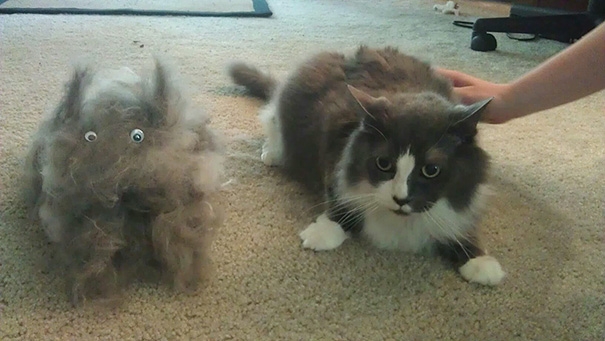
Call us Now ![]() +91-8744012053
+91-8744012053
Mon - Sat ~ 10:00 AM - 6:00 PM
Follow & Like
.png)


Call us Now ![]() +91-8744012053
+91-8744012053
Mon - Sat ~ 10:00 AM - 6:00 PM
Follow & Like
.png)


Shedding is a natural phenomenon in CATS where dead hair makes way for fresh fur. It is a sign of a healthy cat with a rejuvenated coat (a cat that is unwell will show no shedding). Therefore all the cat lovers must accept this process as being a normal and inescapable natural occurrence.
 Image: BoredPanda
Image: BoredPanda
Indoor cat Vs Outdoor cat
If you tend to an outdoor cat then you will notice, it sheds hair during two specific seasons for two very specific reasons.
Spring season is linked to shedding of the layer of undercoat that supplied the cat with necessary warmth during the winter months. The redundant layer falls-off during spring.
Autumn season is the second time the cat will undergo the shedding process to replenish the undercoat for the approaching winter months.
Indoor cats shed much less than the outdoor cats. The indoor cats are exposed to artificial heating in cold months and air conditioning during hot weather as a result their shedding cycle is not able to adhere to a definite scheme and occurs all year round.
Understanding the link between shedding of hair and photoperiod
Photoperiod can be simply defined as the length of time in the 24 hour period during which the animal is exposed to sunlight. The cat’s shedding is directly linked to the photoperiod.
Outdoor cats spend a large number of hours daily in daylight. Seasons such as spring and autumn are characterized by longer and brighter days, therefore cats experience shedding during these times of the year. Colder days are periods of no hair loss or perhaps even if it occurs it is very-very little. The excess fur will help the cat to retain its body heat to combat the chill.
The domesticated pet cat spends most of its time inside the house and instead of direct sunlight is exposed to an artificial source of illumination. Hence its shedding is erratic and also much less compared to its outdoorsy counterpart.
Things you can do to deal with your cat’s shedding
Cats such as the Persian require daily brushing owing to their long locks. Pet wipes can be used to clean its face and mane. Short haired cats with a light/thin coat such as the Burmese or Siamese do not require frequent brushing.
Combing also aids in hair ball control in felines.
Fish oils are rich in Omega-3 fatty acids that can be given to the feline to fortify the health of its skin and coat. Foods laden with Omega-6 will also help in reducing the shedding by softening and strengthening the coat.
A superior quality food that can be easily digested by the pet becomes a necessary condition for achieving optimal wellbeing for the cat.
A cat can be bathed once in every six weeks. However some breeds may require weekly baths.
Extreme cases of shedding that require medical intervention
In some cases shedding may lead the cat to compulsively bite and lick certain areas on its body. Also shedding may take an extreme form of losing hair patches. Losing a lot of hair year round needs to be brought before a veterinarian.
The causes could be a dust or food allergy. Sometimes shedding is induced due to stress. The vet will thoroughly examine the pet to determine a suitable diagnosis and treatment procedure.
__________________________________________________________________________________
Article Resource Box:
http://www.hartz.com/Cats/Health/Medical_And_Preventive_Care/How_to_contol_your_cats_shedding.aspx
http://www.cozycatfurniture.com/cat_newsletters/catnewsletter13.html